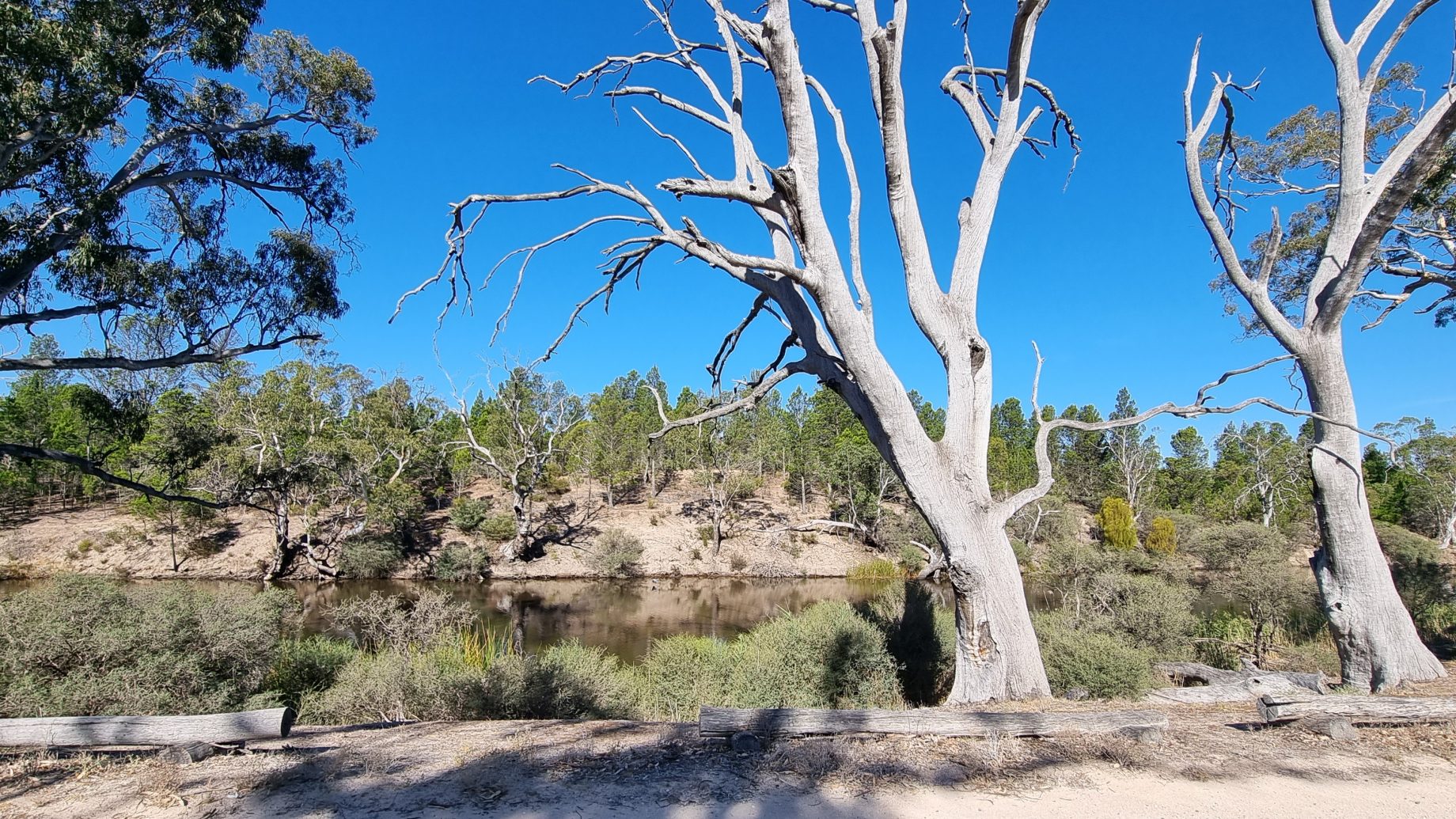Thursday 7th March
The weather forecast for the Labour Day long weekend was not positive, with an extended number of extremely hot days predicted. As always, we decided to brave the weather – we could always return home if the conditions turned out to be too oppressive.
The Tvan had been in for a full service and updates to the battery system, with two lithium batteries replacing the aging AGM batteries and a new battery management system to deal with aforementioned lithium batteries. New tyres were also fitted, along with a full service that saw new bearings and seals, a wheel alignment, and a general inspection of everything that needs to be working well for an enjoyable trip away.
The weekend prior to our departure had us both involved in a tidy up / stocktake of everything in the Tvan. Recently this task has typically involved us paring back what we historically have packed. A meal planner was developed and a shopping list resulted. Some items were purchased over the weekend and packed into the pantry, while fresh fruit and vegies were captured on another list of perishable items that were to be purchased once on our way.
Our regular Pilates session got the day off to a good start and we both returned home just after 10:00am knowing we had been put through our paces. Final items were packed away into the Tvan fridge, a coffee consumed and the house locked up.
Google maps was suggesting a 5-hour drive time to our destination at the Horseshoe Bend campground in Little Desert National Park. Allowing for a stop in Ballarat for lunch (and a visit to the supermarket there to get those last fresh fruit and veggie items), we were likely to be setting up camp just after 5:00pm. We managed to pass through the convoluted road works on the western side of the West Gate Bridge, where a tunnel under the Yarra River is going to eventually alleviate traffic issues. The Western Ring Road was busy, with light and heavy trucks moving goods from one location to another. The highway to Ballarat was a little less busy – although road works around Melton had the traffic slowed to walking pace for some time.
The clock was ticking over 1:00pm when we stopped at ‘Wen and Ware’ (a café in Ballarat) for a light lunch and a quick shop in the nearby supermarket. The local youths were gathered outside a welfare office as we made our way into the supermarket. One shouldn’t judge but the tone of the conversations, the strangled use of what was most likely the English language and their general unkempt appearance suggested there was little chance of them succeeding very far in life.
It wasn’t long before Ballarat was disappearing behind us as we continued westward. Our thoughts turned to the recent fires that swept through to the west and north of Ballarat. We speculated on where we might be when we spotted signs of those fires. Beaufort, then Ararat and then Stawell came and went with no obvious signs, but further west Dadswells Bridge was very lucky to be still intact, with clear evidence the fires had circled the caravan park and jumped the highway just west of the Big Koala. Our journey continued on through Horsham before we eventually turned off the highway and into Dimboola. Once in town, signage clearly led us to the Horseshoe Bend campground. We followed a sealed road that eventually became a well-graded gravel road with the Wimmera River on our left.
The large, expansive camp ground came into view. We drove towards the facilities block and parked up, electing to investigate the best campsite by foot. Every campsite was available at that stage, as we were the only ones in the campground. We opted for a shaded site with enough sunlight to power our solar panels. The Tvan was positioned appropriately on the site and we went through our well rehearsed setup chores before sitting back in the shade of the trees and our awning, where we enjoyed a cooling drink. It was around 33C with almost no breeze under a clear blue sky.
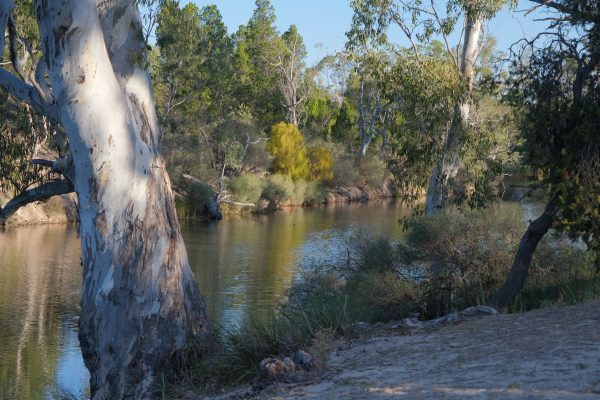
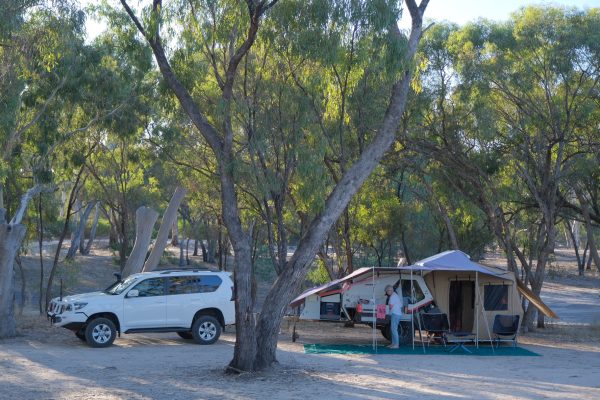
While we settled into a Thai chicken salad for dinner at around 7:00pm, fellow campers began arriving. With ample space, there was no concern about newer arrivals encroaching on our chosen site. The temperature was still around 30C when we retired for the night. The skies remained clear and a star-filled night sky could be viewed through the open skylights in the the Tvan. The temperature eventually began to drop as further campers continued to arrive and set up in darkness. The noises that accompany setting up camp while young children play in the dark continued through to around 10:30pm before all went quiet. The temperature eventually dropped to the predicted 10C. The doona was appreciated in the early hours.
Friday – 8th March
There was a distinct chill in the air as the first signs of light in the sky could be observed through the Tvan skylight. Neither of us were in a hurry to venture outside, so we put the limited mobile phone reception to good use – reading the papers online and checking overnight emails. Eventually Chris ventured outside at around 8:00am and prepared breakfast while late night arrivals were packing up and hitting the road for their next destination.
A leisurely breakfast followed as the chill of the morning was replaced with milder temperatures under the now-familiar blue sky with little to no breeze to speak of. Once breakfast was concluded, the washing up done and everything packed away, we set off on a short walk into the surrounding desert (think Mallee country rather than rolling sand dunes) that eventually circled back to follow the Wimmera river back to our camp site.


In parts, the walk was through low banksia bushes that still retained some of their recent distinctive flowers. Chris spotted a large emu that wasn’t keen to hang around when it saw us. In only a matter of a few steps it was lost from view in the banksia undergrowth. Grey kangaroos pricked up their ears as we approached; they were also on their way when we moved closer. The walk passed through open country with only low bushes holding the topsoil in place. Large ancient gum trees also stood tall and proud with the morning sun shining off their grey and white bark. Their presence signalled the availability of a reliable water supply under the sandy surface of the landscape we were walking through.

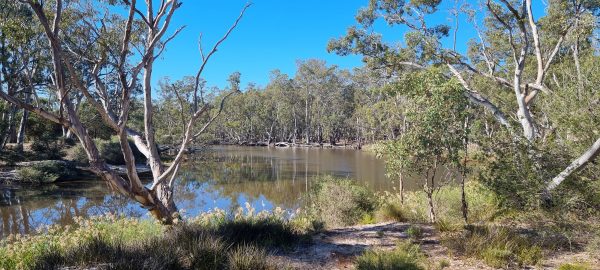



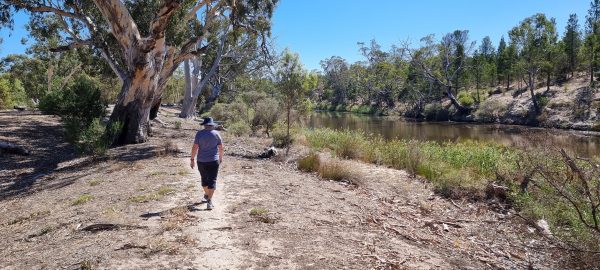
The Wimmera River returned into view and we began circling back to another campsite we wanted to check out for future reference. As it turned out, we preferred the Horseshoe Bend campground but at least we had done the comparison. More emu and kangaroo sightings followed as we followed the river westward. Eventually we returned to our camp site where we enjoyed a late morning tea in the shade of the Tvan awning.
As the temperature continued to rise we decided it was time to try out the waters of the Wimmera River. We speculated on whether the water would be warm or cold. The river depth is controlled by a weir in Dimboola and this may contribute to the lack of current at this time of year. The river had tannin-stained water that, while clear, diminished the ability to spot submerged objects so a cautious approach was adopted while entering the water – which was cool on the surface and much cooler the deeper you went. The swim was refreshing and left us feeling invigorated.
Lunch was a simple affair with chicken salad wraps and fresh fruit, washed down with a cup of tea. During lunch we were alerted to the sound of dry leaves crackling underfoot. A sand monitor (goanna) was ambling along under nearby picnic tables looking for any crumbs that may have been dropped by recent visitors. It appeared set to explore our campsite until Chris stood to take a photo or two – the monitor then retreated to the safety of a nearby gum tree, just metres from us. We watched as it took in the view before eventually deciding to return to the ground in order to continue fossicking for anything edible.

By mid-afternoon another swim was called for. The campground was nearly abandoned except for ourselves and a young couple with two children under 3 years old. They were swimming at the “beach”, which provides a safe and easily accessible entry point to the river. The family were from Phillip Island and were visiting family in Dimboola over the long weekend.
As the day draws to a close it is a pleasant 32C and our thoughts have turned to dinner. Steak and sausages with a tossed salad is on tonight’s menu. The campground is empty except for our presence, although we are expecting further visitors later in the evening as other campers attempt to depart Melbourne in what is often a mass exodus of people getting away for the long Labour Day weekend.
Saturday 9th March
As daylight savings for another summer period draws to a close, the sun is rising much later in the day. First light was just after 7:00am, with sunrise a little after 7:30am. The heat of yesterday was forecast to repeat itself again today but the early morning temperature was in the high teens. The cooler conditions, together with a clear sky and very still conditions, made for a beautiful morning to be outside enjoying a relaxed breakfast.
Following breakfast it was decided we would drive into Dimboola to check out what was on offer in town. Horseshoe Bend campground is about 7kms south of Dimboola, on a gravel all-weather road that eventually becomes a single lane of sealed road as the township draws closer. Much of the drive is beside the Wimmera River which is flanked by ancient river red gums (colloquially known as ‘widow makers’ for their ability to drop massive branches without notice, even in still conditions).
Dimboola is yet another township on the Melbourne to Adelaide rail line and, like the other towns we had driven through on Thursday, its defining wheat silos are currently brimming with grain collected from the recent summer harvest. It is the heart of the wheat and sheep country that dominates the landscape from west of Horsham to beyond the South Australian border. The town is going through a revival phase, after devastating droughts in the early 2000s saw numbers decrease and people leaving the land for places of greater opportunity.


There was a well patronised market in full swing when we arrived in town. Parking was at a premium and we ended up parking a street back from the main drag. The market had a good mix of country wares, including hand made dolls’ clothes, potted herbs, jams and chutneys, bric-a-brac and everything in between. The coffee van was doing great business with a patient queue waiting to place their orders. The surrounding streets were also bustling, with a mix of locals and visitors going about their business. The cafés were busy with locals gathering to catch up with family and friends. The country drawl was evident when passing groups gathered over coffee and cake, and T he recent lack of rain was a noticeable topic of conversation. Visitors were heard discussing the heat wave that had settled over the south-east corner of the country, breaking records along the way.
Our attempt to book a table at the local pub for dinner were thwarted. The pub wasn’t opening for lunch until later in the morning; efforts to ring through a booking were to no avail when we were told they were booked out until 7:00pm and even then there was still no guarantee that we would be seated inside (remember the temperature was predicted to reach nearly 40C later in the day). The positive was that we would be able to get another swim in the Wimmera River, as there would be no hurry to get into town for dinner.
Once back at our campsite, we were quick to change into our bathers and plunge (yet again) into the refreshing waters of the Wimmera River. A small sandy beach could be reached down a flight of stairs. Though quiet now, this beach is obviously a magnet for campers and Dimboola locals wanting river access; much of the rest of the water’s edge along Horseshoe Bend is blocked by fallen branches and a dense cover of bull rushes. We swam, floated, treaded water and generally cooled off.
A family we were sharing the campground with turned up with their two sons, two kayaks and two large inflatable pool rings. The noise levels increased as the boys splashed about, taunting each other to take risks while practicing getting back into their upturned kayaks. Their mum was constantly remonstrating with the boys, explaining that they needed to be quiet, needed to avoid invading our personal space, needed to wear their life jackets correctly, needed to be cautious of the depth of water under the rope swing, etc. Understandably, the boys were well practiced at tuning out by the time their Mum had uttered a word or two.
Later in the day when back swimming, we caught up with the young Phillip Island family with the two young daughters who had been visiting Dimboola for many years – due in part to family connections in the Wimmera. We heard about the shocking case of ‘The Antwerp Exorcism’, now covered in a true-crime podcast. Apparently a church-going pig farmer from Antwerp, roughly 14km north of Dimboola, determined that his wife was overcome by demons, making her do things like dance outside and use bad language. He managed to garner the help of his neighbours (who were members of an ousted church group) and the group’s spiritual leader (an expelled Lutheran) to help rid his wife of the so-called demons. Needless to say it didn’t end well and the ‘possessed’ wife died as a result of the actions taken.

The later afternoons here have been as enjoyable as the early mornings. The temperature has eventually dropped, the sky has remained clear and the silence has been most enjoyable. The final rays of sunlight gave way to a sky full of stars as we retreated into the confines of the Tvan (with skylights and all windows open in the hope they would allow the cooler air of the night into the van). Fans were turned on and adjustments made to be sure the breeze hit the right spot for both of us. The overnight temperature eventually dropped to below 20C just before first light.
Sunday 10th March
It was yet another brilliant start to the day under cool, clear skies. We had discussed cutting short our time away even before leaving home on Thursday – the forecast had always been for multiple days nearing 40C and this had played out during our time in the Little Desert National Park. Last night we decided to head home today. We would spend the hottest part of the day in the comfort of our air-conditioned Prado and hopefully miss the traffic that would be heading back to Melbourne on Monday.

Chris was up first, shortly followed by Wendy; an unhurried breakfast was enjoyed while watching the start of another day over the national park. Birds were chasing the insects in the early morning sun while others swooped down on interlopers in their territory. The kookaburras were at the top of the pecking order while magpies ran a close second. Smaller, insect-eating birds darted in and out of the cover of the trees to collect their breakfast.
Following breakfast we adhered to our regular pack-up routine, leaving only the rear canvas erect so we could go for a final swim and change into dry clothes before departing. That last swim was very refreshing after our efforts to pack everything away in warming conditions as the sun rose higher in the sky.
Once packing was finalised the Tvan was hooked up to the Prado and we set off for Dimboola, where we would join the Western Highway for our journey home. The expansive paddocks (that were now covered in browned-off stubble, following the harvest) extended to the horizon. The railway siding at Horsham, with its stand-out silos, was surrounded by well-organised mounds of grain covered by massive tarpaulins. The movement of grain into the storage mounds was ongoing, with heavily-laden trucks depositing their grains in neat piles that were being positioned by conveyors into ever-increasing mounds. We have subsequently learnt that much of the grain destined for export is containerised at the Horsham terminal before it is transported to Port Melbourne.
The Grampians came into view as we left Horsham behind us. The fires that threatened Dadswells Bridge left blackened trees on either side of the Western Highway that reached deep into the centre of town, the CFA had obviously put in a massive effort to keep infrastructure losses to a minimum. Stawell was upon us shortly after Dadswells Bridge, then it was on to Great Western and Ararat before we decided to stop for lunch at Beaufort. A dry heat confronted us when we left the Prado to walk the short distance to a local café.
The drive from Beaufort to Mentone was uninterrupted. Our decision to leave a day early was vindicated in terms of avoiding the returning traffic into Melbourne. The Tvan was quickly reversed into place beside the garage and we retreated into the house, with the air-conditioning and ceiling fans turning on high.
We have locked in the Little Desert National Park for future trips away. It is within easy reach of Melbourne for a 3 – 4 day break; it will also be well placed to stop for a night when headed further westward on a longer trip. We agreed that the kayak should be packed for our next multi-day visit; ideally, spring and autumn would be the best time to enjoy the national park here. We also felt that the Horseshoe Bend camping area was our favourite, having checked out the other nearby campground. Camp fires are more likely during this cooler parts of the year. No further camping trips away are planned until late June, when we set our sights on finally visiting Arnhem Land and the Cobourg Peninsula.
